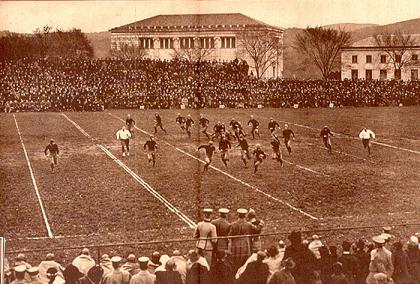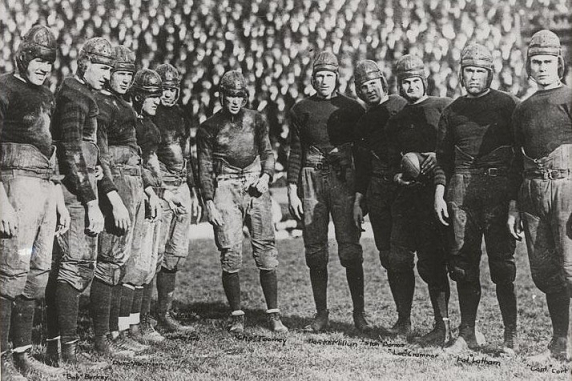
Pictured above is California's 1920 "Wonder Team" at the Rose Bowl. 9-0 Cal outscored opponents 510-14, and they shocked the nation by trouncing previously unbeaten and untied Ohio State in the Rose Bowl 28-0, leaving them the consensus choice as 1920 mythical national champion (MNC).

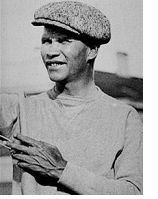 I've
been summarizing teams East-to-West in previous national championship
articles, but this time I am going to start with the juggernaut out
West. California had only been playing football for 5 years prior to
this season. Like most of the schools in their state, they gave up
football after the 1905 season and played rugby instead 1906-1914.
Their rugby coach, James Schaeffer, traveled the country talking to
football coaches and learning the game prior to the Fall of 1915, then
coached his old rugby team to an 8-5 record in the school's first
season playing football again. He then convinced one of the coaches he
had talked to prior to the season, Andy Smith, to come out West and
take over.
I've
been summarizing teams East-to-West in previous national championship
articles, but this time I am going to start with the juggernaut out
West. California had only been playing football for 5 years prior to
this season. Like most of the schools in their state, they gave up
football after the 1905 season and played rugby instead 1906-1914.
Their rugby coach, James Schaeffer, traveled the country talking to
football coaches and learning the game prior to the Fall of 1915, then
coached his old rugby team to an 8-5 record in the school's first
season playing football again. He then convinced one of the coaches he
had talked to prior to the season, Andy Smith, to come out West and
take over.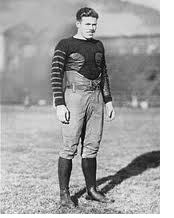 The
key San Diego High School players who followed Nibs Price to Cal were
Brick Muller, Stan Barnes, Pesky Sprott, and Cort Majors.
The
key San Diego High School players who followed Nibs Price to Cal were
Brick Muller, Stan Barnes, Pesky Sprott, and Cort Majors.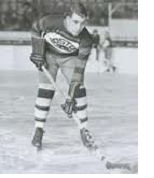 I summarized Harvard in my 1919 national championship article,
and I covered some of the 1920 starters and their coach Robert Fisher
there. The key losses from the 1919 team were star halfback Eddie Casey
and fullback/kicker Ralph Horween. But the team's new players more than
made up for those losses, and though this Harvard team finished with a
similar record as the 1919 team did (they were 9-0-1 in 1919, 8-0-1 in
1920),
I summarized Harvard in my 1919 national championship article,
and I covered some of the 1920 starters and their coach Robert Fisher
there. The key losses from the 1919 team were star halfback Eddie Casey
and fullback/kicker Ralph Horween. But the team's new players more than
made up for those losses, and though this Harvard team finished with a
similar record as the 1919 team did (they were 9-0-1 in 1919, 8-0-1 in
1920), 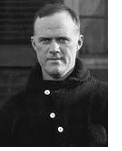 Princeton had previously won mythical national championships in 1903 and 1906
Princeton had previously won mythical national championships in 1903 and 1906